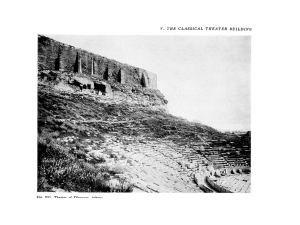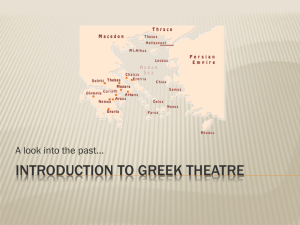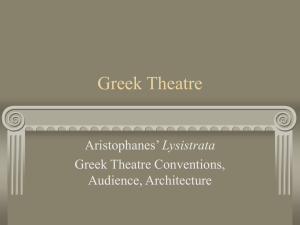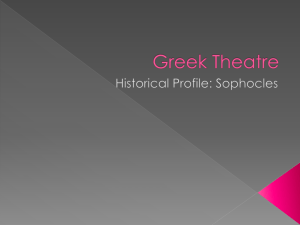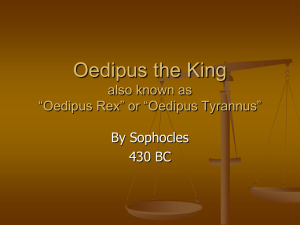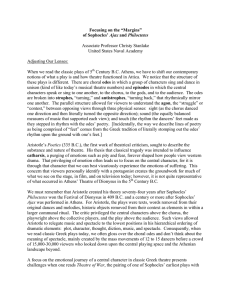greek theatre - ENGLISH 10 and HONORS ENGLISH 10
advertisement
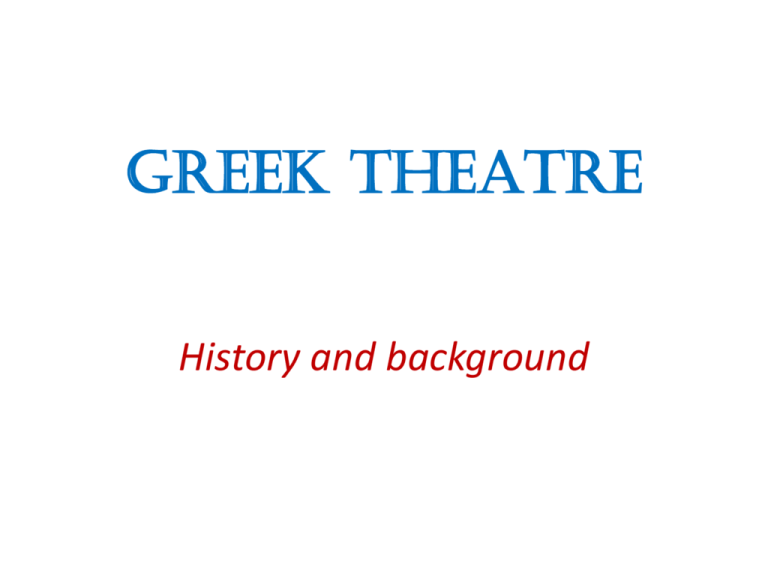
GREEK THEATRE History and background Origins of Drama • Between 600 and 200 BC, the ancient Athenians created a theatre culture whose form, technique and terminology have lasted two millennia, and they created plays that are still considered among the greatest works of world drama. • Their achievement is truly remarkable when one considers that there have been only two other periods in the history of theatre that could be said to approach the greatness of ancient Athens - Elizabethan England and, perhaps the Twentieth Century. • The greatest playwright of Elizabethan England was Shakespeare, but Athens produced at least five equally great playwrights. • The Twentieth Century produced thousands of fine plays and films, but their form and often their content are based on the innovations of the ancient Athenians The Cult of Dionysus • The theatre of Ancient Greece evolved from religious rites which date back to at least 1200 BC. At that time, Greece was peopled by tribes that we in our arrogance might label 'primitive'. In northern Greece, in an area called Thrace, a cult arose that worshipped Dionysus, the god of wine and fertility • These rites were given a regular form and raised to the rank of artistic poetry in about 600 BC. Introduced into Athens shortly before 500 BC. By this time, however, it had ceased to concern itself exclusively with the adventures of Dionysus and begun to choose its subjects from all periods of Greek mythology. In this way, over time this would evolve into stories in 'play' form: drama. History • By 600 BC Greece was divided into city-states, separate nations centered in major cities and regions. The most prominent city-state was Athens, where at least 150,000 people lived. • It was here that the Rites of Dionysus evolved into what we know today as theatre. Since Athens was located in a region called Attica, Greek and Athenian theatre are sometimes referred to as Attic Theatre. Thespis • In about 600 BC, Arion of Mehtymna (Corinth) wrote down formal lyrics for the dithyramb. Some time during the next 75 years, Thespis of Attica added an actor who interacted with the chorus. This actor was called the protagonist, from which the modern word protagonist is derived, meaning the main character of a drama. • Later, Sophocles introduced a second speaker which resulted in the creation of theatre. Tradition ascribes this innovation to one Thespis, and even gives him a date; he is said to have performed Athens about 534 BC. Whether this is true of not, his name has achieved immortality in theatrical jargon 'actors' and 'Thespians' are synonymous. Ampitheaters • • • During this time, major theatres were constructed, notably the theatre at Delphi, the Attic Theatre and the Theatre of Dionysus in Athens. The Theatre of Dionysus, built at the foot of the Acropolis in Athens, could seat 17,000 people. During their heyday, the competitions drew as many as 30,000 spectators. The words theatre and amphitheatre derive from the Greek word theatron, which referred to the wooden spectator stands erected on those hillsides. Similarly, the word orchestra is derived from the Greek word for a platform between the raised stage and the audience on which the chorus was situated. Actors and the Plays • Plays were performed in the daytime. The annual drama competitions in Athens were spread over several, entire days. Actors probably wore little or no makeup. • Instead, they carried masks with exaggerated facial expressions. They also wore cothornos, or buskins, which were leather boots laced up to the knees. There was little or no scenery. • Initially, most of the action took place in the orchestra. Later, as the importance shifted from the chorus to the characters, the action moved to the stage. The Actors & The plays • All male • They wore masks, wigs and high boots to add formality • Acted in daylight, no curtains and very few sets. • Written in poetic verse, not prose. • Audience was familiar with basic story from mythology and new more than the actors did. Tragedy – What is it? • Tragedy, derived from the Greek words tragos (goat) and ode (song), told a story that was intended to teach religious lessons. Much like Biblical parables, tragedies were designed to show the right and wrong paths in life. • The tragic protagonist is one who refuses out of either weakness or strength to give in to fate. Most often, the protagonist's main fault is hubris, a Greek, and English word meaning false or overweening arrogance. • It could be the arrogance of not accepting ones destiny (i.e. as in Oedipus Rex), the arrogance of assuming the right to kill (Agamemnon), or the arrogance of assuming the right to seek vengeance (Orestes). • Whatever the root cause, the protagonist's ultimate collision with fate, reality, or society is inevitable and irrevocable. Tragedy • The traditional tragedy in Aeschylus' time (circa 475 BC) consisted of the following parts: 1. Prologue, which described the situation and set the scene 2. Parados, an ode sung by the chorus as it made its entrance 3. Five dramatic scenes, each followed by a Komos, an exchange of laments by the chorus and the protagonist 4. Exodus, the climax and conclusion The Three Unities • Unity of time – all action takes place in 24 hours. Dialogue provided background information. • Unity of place – Action was limited to one setting. • Unity of subject – the focus was on the main character and there were no subplots. What is the Chorus? • 15-20 men representing the citizens • Always on stage and sang and danced • Had a leader who carried on a dialoque with the main characters or the rest of the chorus Purpose of the Chorus • • • • • • • • • Set the tone Give background information Recall past events Interpret and summarize events Ask questions At times – give opinions Give advice, if asked Stay objective (do not disagree with protagonist) Act like a jury of elders or wise men and reach a moralistic conclusion at the end of the play



